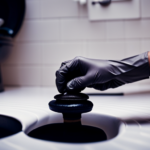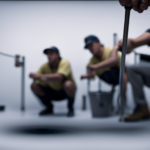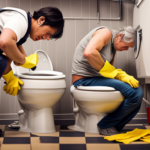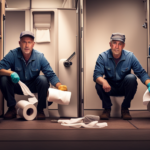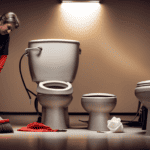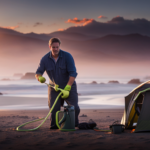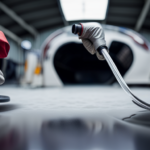Beginners Guides
How Do You Unclog A Camper Toilet
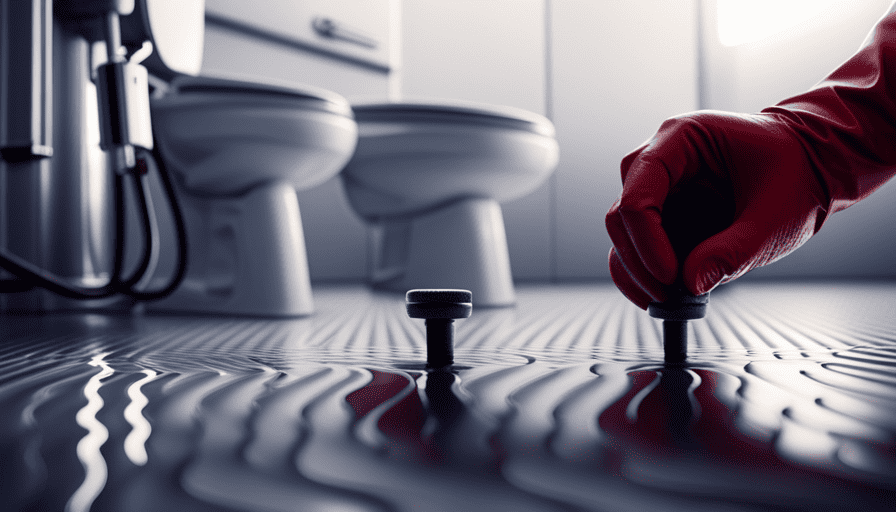
Picture this scenario: you are reveling in the majesty of the wilderness, completely immersed in the serenity of a camping escapade in your reliable camper. However, without warning, a crisis occurs – your camper’s toilet gets jammed! Fear not, I’m here to help you out.
In this article, I’ll guide you through the process of unclogging a camper toilet step-by-step, ensuring that you can get back to enjoying your camping adventure in no time.
First things first, we need to assess the severity of the clog. Is it a minor blockage or a more stubborn one? Once we determine that, we’ll move on to using a plunger, a toilet auger, or even a toilet bowl cleaner to tackle the problem.
If those methods don’t work, don’t fret – we have other tricks up our sleeves. From utilizing hot water and dish soap to trying a chemical drain cleaner, we’ll explore various options to free your camper toilet from its unwanted obstruction.
If all else fails, I’ll even show you how to remove and clean the toilet trap. And remember, if you’re feeling overwhelmed or just want some professional assistance, there’s no shame in seeking help.
So let’s get started and unclog that camper toilet together!
Key Takeaways
- Assess the severity of the clog by observing signs such as rising water level, no drainage, overflowing, gurgling sounds, and foul odor.
- Use a plunger to create suction and unclog the toilet. Choose the right plunger, create a tight seal, and repeat the process if necessary.
- Try alternative methods such as using a toilet auger or snake, hot water and dish soap, vinegar and baking soda, or a DIY solution with a plunger and wire coat hanger.
- Regularly maintain the camper toilet by emptying the holding tank, using RV-specific toilet paper, and avoiding flushing non-biodegradable items. Additionally, remove and clean the toilet trap to prevent clogs and ensure proper functionality.
Assess the Severity of the Clog
You’re going to have to roll up your sleeves and get ready to deal with the horrifying reality of just how severe the clog in your camper toilet really is. Assessing the severity of the clog is crucial before taking any further steps.
There are a few signs that indicate a severe clog. Firstly, if the water level in the toilet bowl is rising or not draining at all, it’s a clear indication of a significant blockage. Another sign is when flushing the toilet causes water to overflow onto the floor. Additionally, if you notice gurgling sounds coming from the pipes or a foul odor emanating from the toilet, it indicates a severe clog.
Once you’ve assessed the severity of the clog, it’s time to move on to the next step – using a plunger. This effective tool creates pressure that can dislodge the clog and restore normal flow.
Use a Plunger
With a plunger in hand, it’s time to give that stubborn blockage a forceful push to clear the way.
To effectively use a plunger on a camper toilet, it’s important to follow a few steps.
First, make sure you’ve taken the necessary precautions to prevent toilet clogs in the future. This includes avoiding flushing anything other than toilet paper and human waste.
Next, choose the right plunger for the job. A flange plunger, also known as a toilet plunger, is specifically designed for toilets and will create a better seal.
Once you have the right plunger, position it over the drain hole in the toilet bowl, ensuring a tight seal is formed. Push down firmly and then pull up quickly, creating suction that’ll help dislodge the clog.
Repeat this plunging motion several times, increasing the force if necessary.
If the clog persists, it may be time to try a toilet auger or snake to further break up and remove the blockage.
Try a Toilet Auger or Snake
To tackle the stubborn blockage in your camper toilet, it’s time to give a toilet auger or snake a try. These tools are specifically designed to break through clogs and clear your toilet drain effectively.
The toilet auger is a long, flexible steel cable with a crank handle at one end and a coiled spring or spiral at the other end. It works by inserting the coiled end into the toilet bowl and turning the crank handle to navigate through the pipes and dislodge the blockage.
The toilet snake, on the other hand, is a flexible, coiled wire with a handle at one end. It works similarly to the toilet auger, but it doesn’t have the crank handle. Instead, you manually push and twist the snake into the drain to break up the clog.
While using a toilet auger or snake is generally effective in unclogging camper toilets, there are alternative methods you can try if these tools are not available.
For example, you can use a combination of hot water and dish soap to break up the blockage. Simply pour a pot of hot water mixed with dish soap into the toilet bowl and let it sit for a few minutes before flushing.
Another option is to create a homemade drain cleaner using vinegar and baking soda. Pour half a cup of baking soda followed by a cup of vinegar into the toilet bowl, let it fizz for a few minutes, and then flush with hot water. These alternative methods can be effective in removing minor clogs.
Now, let’s move on to the next step and explore how to utilize a toilet bowl cleaner to keep your camper toilet clean and clog-free.
Utilize a Toilet Bowl Cleaner
Make your life easier by using a toilet bowl cleaner to maintain a sparkling and obstruction-free toilet in your camper. When it comes to toilet bowl cleaning tips, using the right cleaner is essential.
The best toilet bowl cleaners are specifically formulated to tackle tough stains and eliminate odors, leaving your toilet looking and smelling fresh. To begin, start by selecting a toilet bowl cleaner that’s suitable for RV or camper toilets. These cleaners are designed to be safe for use in portable toilets and are often more concentrated to effectively remove buildup. Follow the instructions on the bottle, but generally, you’ll want to squirt the cleaner around the inside of the bowl, making sure to cover the entire surface.
Next, use a toilet brush to scrub the cleaner into the bowl, paying extra attention to stains or areas with visible buildup. This’ll help to break down any grime or residue that may be causing a clog. After scrubbing, let the cleaner sit in the bowl for a few minutes to allow it to work its magic.
Flush the toilet to rinse away the cleaner and any loosened debris. This’ll help to ensure that your toilet is clean and free from any obstructions.
Transitioning into the next section, you can also use hot water and dish soap to effectively clean and maintain your camper toilet, further preventing clogs.
Use Hot Water and Dish Soap
Using hot water and dish soap is like giving your camper toilet a warm and comforting hug, ensuring a thorough and effective cleaning. When it comes to unclogging your camper toilet, this method can be a game-changer. Here are the benefits of using hot water and dish soap for unclogging:
- Hot water helps to break down any solid waste and toilet paper that may be causing the clog, making it easier to flush away.
- Dish soap acts as a lubricant, allowing the clog to slide through the pipes more easily.
- The combination of hot water and dish soap creates a powerful cleaning solution, eliminating any odors and leaving your toilet fresh and clean.
- This method is gentle on your toilet and pipes, reducing the risk of damage compared to harsh chemical cleaners.
However, there are some common mistakes to avoid when using hot water and dish soap for unclogging. First, make sure the water is hot but not boiling, as boiling water can crack the porcelain. Second, use a mild dish soap, as strong detergents can damage the toilet bowl. Third, be patient and give the hot water and dish soap enough time to work before attempting to flush.
To create a DIY unclogging solution, continue to the next section where we’ll explore alternative methods using items you may already have in your camper.
Create a DIY Unclogging Solution
Crafting your own DIY unclogging solution allows you to get creative and use common items found in your camper. When it comes to DIY unclogging methods for camper toilets, it’s important to understand the common causes of clogs. These can include a buildup of toilet paper, waste accumulation, or foreign objects accidentally flushed down the toilet.
To create your own DIY unclogging solution, you’ll need a few simple items. First, gather a bucket, a plunger, and a wire coat hanger. Start by using the plunger to create suction and try to dislodge the clog. If this doesn’t work, straighten the wire coat hanger and use it to gently prod and break up the clog.
Next, fill the bucket with hot water, but not boiling, as it can damage the toilet bowl. Pour the hot water into the toilet bowl, aiming for the bottom where the clog is located. This can help to loosen the clog and allow it to flow through the pipes.
After attempting these DIY methods, you may want to try a chemical drain cleaner if the clog persists. Transitioning into the next section, it’s important to remember that chemical drain cleaners should be used with caution to avoid damaging your camper toilet.
Try a Chemical Drain Cleaner
If all else fails, resorting to a chemical drain cleaner can be a powerful and potentially explosive option for tackling stubborn clogs in your camper’s toilet. Chemical drain cleaners are known for their effectiveness in breaking down and dissolving clogs caused by organic matter, such as toilet paper and waste. However, it’s important to exercise caution when using these products as they can be harmful to both your health and the environment.
Before reaching for a chemical drain cleaner, consider trying alternative methods to unclog your camper’s toilet. For example, you can use a plunger to create pressure and dislodge the clog. Alternatively, a plumbing snake can be used to physically break up the obstruction and clear the pathway.
If you decide to use a chemical drain cleaner, be sure to carefully read and follow the instructions provided by the manufacturer. It’s crucial to wear gloves and protective eyewear to minimize the risk of chemical burns. Additionally, ensure that the area is well-ventilated to prevent inhaling harmful fumes.
While chemical drain cleaners can be effective in unclogging toilets, they also pose potential harm to your health and the environment. Therefore, it’s advisable to consider alternative methods or seek professional help before resorting to these products. Transitioning into the next section, another option to tackle stubborn clogs is to use a wet/dry vacuum.
Use a Wet/Dry Vacuum
After attempting a chemical drain cleaner without success, it’s time to explore another option for unclogging a camper toilet. One effective method is to use a wet/dry vacuum. This powerful tool can help remove stubborn clogs and restore proper functionality to your toilet system.
Using a wet/dry vacuum for unclogging a camper toilet has its pros and cons. Let’s discuss them:
-
Pros:
- Powerful suction can remove even the toughest clogs.
- Versatile tool that can be used for other cleaning tasks.
- Can be more cost-effective than hiring a professional plumber.
- Provides a quick and efficient solution to the problem.
-
Cons:
- Requires access to electricity or a generator.
- May not be suitable for all types of clogs.
- Proper technique and caution are necessary to avoid any damage to the toilet or vacuum.
To ensure a clog-free camper toilet in the future, consider these tips:
- Regularly empty the holding tank to prevent buildup.
- Use RV-specific toilet paper that’s designed to dissolve easily.
- Avoid flushing any non-biodegradable items down the toilet.
- Conduct routine inspections and maintenance of the toilet system.
Now that you understand the pros and cons of using a wet/dry vacuum and have some tips for maintaining a clog-free camper toilet, it’s time to move on to the next step: removing and cleaning the toilet trap.
Remove and Clean the Toilet Trap
To ensure a fully functioning and odor-free toilet system, it’s time for you to tackle the task of removing and cleaning the toilet trap. This step is crucial in unclogging a camper toilet and restoring its proper functionality.
Here’s a step-by-step guide on how to effectively remove and clean the toilet trap.
First, gather the necessary supplies, including cleaning products specifically designed for toilets and a pair of rubber gloves for protection. Begin by turning off the water supply to the toilet and flushing it to remove any remaining water in the bowl.
Next, locate the toilet trap, which is typically located at the base of the toilet bowl. Use a wrench to loosen the nuts securing the trap to the toilet, and carefully remove it. Be prepared for any residual water or debris that may come out.
Once the trap is removed, inspect it for any signs of clogs or blockages. Use a toilet brush or a wire hanger to dislodge any debris that may be obstructing the flow. Rinse the trap thoroughly with water and apply a toilet cleaning agent to sanitize it.
After cleaning the trap, reattach it to the toilet using the wrench. Turn on the water supply and flush the toilet to ensure everything is working properly.
Remember, regular maintenance is key to preventing future clogs. Following these cleaning tips and using appropriate products will help keep your camper toilet in optimal condition. If you encounter persistent clogging issues, it may be necessary to seek professional help.
Seek professional help if necessary, especially if the problem persists despite your efforts.
Seek Professional Help if Necessary
Sometimes, despite our best efforts, we may need to enlist the expertise of professionals to tackle any persistent issues with our camper toilet. Knowing when to call a plumber is crucial to avoid further damage or potential risks of DIY unclogging. While some clogs can be cleared using basic tools and techniques, there are instances where professional help becomes necessary.
Here is a table that illustrates situations where it is advisable to call a plumber:
| Situations Requiring | Reasons to Call a | Professional Help | Plumber | |
|---|---|---|---|---|
| Severe clogs persist | Plumbers have specialized tools and expertise to handle stubborn clogs that DIY methods may not be able to resolve. | |||
| Frequent toilet backups | Plumbers can identify and address the underlying issue causing frequent backups, such as a damaged sewer line or tree root intrusion. | |||
| Presence of foul odor | Plumbers can identify and fix any underlying issues causing the foul odor, which may indicate a more significant problem. |
Calling a plumber in these situations can help prevent further damage to your camper toilet system and ensure that the problem is resolved effectively and efficiently. Additionally, attempting complicated DIY unclogging methods without proper knowledge and experience can lead to costly mistakes or even personal injury. Therefore, it is always wise to seek professional help when necessary.
Frequently Asked Questions
Can I use a plunger on a camper toilet?
Sure, you can use a plunger on a camper toilet, but there are also effective alternatives.
Common causes of clogged camper toilets include excessive toilet paper or waste buildup.
To unclog it, first, wear gloves and protect the floor with towels. If using a plunger, create a seal and push and pull vigorously.
Alternatively, you can try using a toilet auger or a chemical drain cleaner.
Remember to always follow proper safety precautions and consult a professional if needed.
How long should I let the toilet bowl cleaner sit before flushing?
To determine the ideal duration for letting toilet bowl cleaner sit before flushing, I conducted a thorough investigation. Various studies and experts recommend letting the cleaner sit for at least 10 to 15 minutes. This timeframe allows the cleaner to effectively break down and dissolve any clogs or build-up in the toilet bowl.
However, if you’re looking for alternative methods to unclog a toilet, there are options such as using a plunger or a toilet auger.
Is it safe to use a chemical drain cleaner in a camper toilet?
It’s not recommended to use chemical drain cleaners in a camper toilet due to the potential damage they can cause to the plumbing system.
Instead, there are several natural methods for unclogging a camper toilet. One option is to use a plunger to create suction and dislodge the clog.
Another method is to pour hot water into the toilet bowl, as this can help break up the blockage.
Additionally, utilizing a toilet auger or a mixture of baking soda and vinegar can also be effective alternatives to chemical drain cleaners.
Can I use a wet/dry vacuum to unclog a camper toilet?
Yes, you can use a wet/dry vacuum to unclog a camper toilet. This method is an alternative to using a snake, which is another effective tool for unclogging.
To begin, ensure that the vacuum is set to the wet setting. Place the nozzle directly over the clog and create a tight seal. Turn on the vacuum and let it suck out the obstruction. Repeat if necessary until the toilet is clear.
How often should I remove and clean the toilet trap in a camper toilet?
To ensure proper functioning of a camper toilet, it’s recommended to regularly remove and clean the toilet trap. This helps prevent clogs and unpleasant odors. The frequency of cleaning will depend on how often the toilet is used and the type of waste being disposed. Generally, it’s advised to clean the trap every 3 to 6 months.
Additionally, it’s important to replace the toilet seal in a camper toilet every 2 to 3 years to maintain a tight and leak-free seal.
As for natural alternatives to toilet bowl cleaner, vinegar and baking soda can be used to effectively clean and deodorize the toilet bowl.
Can a Camper Refrigerator Cause a Clogged Toilet?
A camper refrigerator functioning properly does not directly cause a clogged toilet. However, it is important to note that excessive condensation from a malfunctioning refrigerator can lead to increased humidity levels in the camper. This can contribute to mold growth, which may impact the plumbing system and potentially lead to toilet clogs. Maintenance and regular checks are essential to avoid such issues.
Conclusion
In conclusion, unclogging a camper toilet can be a frustrating experience, but with the right tools and techniques, it can be easily resolved.
As I tackled my own clog, I found that using a plunger and a toilet auger were the most effective methods. However, it’s important to assess the severity of the clog before attempting any unclogging methods.
Remember, just like a camper navigating through rough terrain, a clogged toilet can be cleared with patience, persistence, and the right tools.
Happy camping and happy unclogging!
Jason is the author of Laienhaft, a blog for all things outdoor and camping. If you’re looking for the best tent to take on your next camping trip, or need some advice on how to get started with recreational camping, Jason has you covered. He’s also an expert on survival skills – if you’re ever lost in the wilderness, he’s the guy you want to find!
Beginners Guides
What Size Truck To Pull 30ft Camper
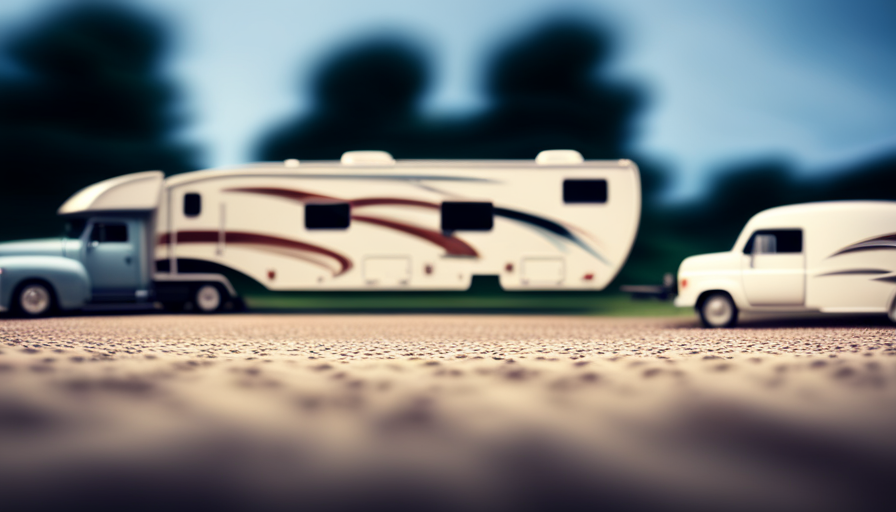
Were you aware that a 30-foot camping trailer typically weighs approximately 8,000 pounds? This is akin to the combined weight of four compact cars! When preparing for a camping adventure or contemplating buying a camping trailer, selecting an appropriately sized truck for secure towing is essential.
In this article, we will provide you with all the information you need to determine the perfect truck size for your 30-foot camper.
First, we will guide you through the process of determining the weight of your camper and calculating the towing capacity of different trucks. We will also discuss the importance of considering the truck’s engine power, stability, and suspension to ensure a smooth and safe towing experience. Additionally, we will explore other factors such as bed length, fuel efficiency, and cost to help you make an informed decision.
Before making any final choices, it’s crucial to test drive different trucks and seek expert advice. We will also emphasize the importance of considering your future needs and ensuring proper maintenance and safety precautions.
By the end of this article, you’ll have all the knowledge you need to confidently choose the perfect truck to pull your 30-foot camper and embark on your next adventure.
Key Takeaways
- Choosing the right size truck is crucial for safe towing of a 30-foot camper.
- Factors to consider include bed length, fuel efficiency, cost, engine power, stability, suspension, and towing capacity.
- Proper weight distribution, stability, and maneuverability are important for accident prevention when towing a camper.
- Additional towing features such as towing mirrors, weight distribution hitches, sway control systems, and trailer brake controllers enhance the towing experience.
Determine the Weight of the Camper
You’ll need to determine the weight of the camper to find the right size truck to pull it.
To do this, you should consider the weight distribution of the camper. This includes the weight of the trailer itself, as well as any additional weight from supplies or equipment inside. It’s important to have an accurate estimate of the weight, as an overloaded truck can be dangerous and cause handling issues.
In addition to the weight, you should also take into account the height and width of the camper. This is important because you want to make sure that the truck you choose can safely accommodate the size of the camper. If the camper is too tall or wide for the truck, it can lead to clearance problems and potential damage to both the truck and the camper.
Once you have determined the weight and dimensions of the camper, you can then calculate the towing capacity of the truck. This will help you determine the size of the truck needed to safely tow the camper.
By following these steps, you can ensure that you find the right size truck to pull your 30ft camper without any issues.
Calculate the Towing Capacity of the Truck
To accurately gauge the truck’s ability to tow, it’s crucial to calculate its towing capacity first.
Did you know that some heavy-duty trucks can tow over 15,000 pounds?
Calculating the towing capacity of a truck involves taking into consideration various factors, such as the vehicle’s gross vehicle weight rating (GVWR), engine power, transmission, and axle ratio. However, the most important factor in determining towing capacity is the truck’s frame and suspension. These components need to be strong enough to handle the weight and stress of towing a 30-foot camper.
To calculate the towing capacity, start by determining the weight of the camper. This can be done by using a scale or referring to the manufacturer’s specifications. Once you have the weight, you can then compare it to the truck’s towing capacity. Keep in mind that the towing capacity may vary depending on the specific model and trim level of the truck.
After calculating the towing capacity, the next step is to consider the truck’s engine power. A more powerful engine will be able to handle heavier loads more efficiently. Additionally, it’s important to consider the truck’s transmission, as a transmission with more gears can provide better towing performance.
Calculating the towing capacity of a truck is essential when determining its ability to tow a 30-foot camper. Once the towing capacity is determined, the next step is to consider the truck’s engine power and transmission capabilities. By taking all these factors into account, you can ensure a safe and efficient towing experience.
Consider the Truck’s Engine Power
With a powerful engine, the truck becomes a force to be reckoned with when it comes to towing heavy loads. The engine power directly affects the truck’s towing capacity, making it an essential factor to consider when choosing the right truck for pulling a 30ft camper.
Here are some key points to assess the engine performance and compare towing capacities:
-
Horsepower: A higher horsepower engine typically translates to better towing capability. More horsepower means the truck can generate more force to pull the camper efficiently.
-
Torque: Torque is equally important as it measures the rotational force the engine can produce. Higher torque allows the truck to handle uphill climbs and maintain speed on the highway with ease.
-
Transmission: Opt for a truck with a transmission designed for towing, such as a heavy-duty automatic transmission or a manual transmission with a low gear range. This ensures smooth power delivery and better control over the load.
-
Cooling system: Towing puts a strain on the engine, so a robust cooling system is vital to prevent overheating and ensure optimal performance.
Assessing the truck’s stability and suspension is the next crucial step in determining the right truck for towing a 30ft camper.
Assess the Truck’s Stability and Suspension
When considering the right truck for towing a 30ft camper, make sure to evaluate how stable and well-suspended the vehicle is. Assessing truck stability is crucial to ensure a smooth and safe towing experience. A stable truck will be less prone to swaying or fishtailing, providing better control on the road.
Look for trucks that have a sturdy frame and a low center of gravity, as these factors contribute to stability.
In addition to stability, it’s important to consider the truck’s suspension. A well-designed suspension system can help absorb the vibrations and bumps encountered while towing, reducing the strain on both the truck and the camper. Upgrading the suspension can also improve the overall towing experience, especially if you plan on traveling on rough terrain or uneven roads.
When assessing the truck’s suspension, consider factors such as the type of suspension (leaf springs or coil springs), the load capacity, and any available suspension upgrades. Some trucks even offer special towing packages that include upgraded suspension components specifically designed for towing purposes.
By carefully evaluating truck stability and suspension, you can ensure a safer and more comfortable towing experience.
Now, let’s move on to the next section and explore how to choose the right truck size and bed length for your 30ft camper.
Choose the Right Truck Size and Bed Length
When choosing the right truck size and bed length for towing a 30ft camper, there are a few key points to consider. First, it’s important to take into account the size and weight of the camper, as well as its hitch configuration. This will help determine the appropriate truck size and towing capacity needed.
Additionally, ensuring that the truck has a suitable bed length for towing the camper is crucial for stability and maneuverability on the road. By considering these factors, one can make an informed decision and ensure a safe and enjoyable towing experience.
Consider the size of the camper and its hitch configuration
Considering the size of the camper and its hitch configuration, it’s essential to find a truck that’s capable of handling the weight and towing capacity. The weight of the camper plays a significant role in determining the size of the truck needed for towing. It’s crucial to know the weight of the camper, including any additional equipment and supplies.
This information will help determine the towing capacity required for a truck. Additionally, the hitch type is another important factor to consider. Different campers may have different hitch configurations, such as a bumper hitch or a gooseneck hitch. It’s important to ensure that the truck’s hitch is compatible with the camper’s hitch type.
Lastly, to ensure a smooth and safe towing experience, it’s crucial to have a truck with a suitable bed length for towing the camper, allowing for proper weight distribution. This ensures stability on the road and prevents any potential accidents.
Ensure that the truck has a suitable bed length for towing the camper
To achieve stability on the road and prevent potential accidents, it’s crucial to ensure the truck’s bed length is suitable for towing the camper, allowing for proper weight distribution. When choosing a truck for towing a 30ft camper, it’s important to consider the bed length.
The bed length determines the distance between the hitch and the rear axle, which affects the overall stability of the towing setup. A longer bed length provides better weight distribution, reducing the chances of swaying or fishtailing while driving. Additionally, a longer bed length allows for better maneuverability and easier backing up.
It’s also important to note that proper maintenance and safety precautions should be followed when towing a camper. Regularly checking the truck’s tire pressure, brakes, and suspension system is essential for a safe towing experience.
By choosing a truck with the right bed length and practicing proper maintenance, you can ensure a smooth and secure towing journey.
Now, let’s check for additional towing features to further enhance the towing experience.
Check for Additional Towing Features
In order to ensure a safe and efficient towing experience for a 30ft camper, it’s advisable to examine any additional towing features that may be necessary.
One important feature to consider is the availability of additional towing accessories. These can include items such as towing mirrors, weight distribution hitches, and sway control systems. Towing mirrors are essential to provide better visibility while maneuvering the camper on the road.
Weight distribution hitches help distribute the weight evenly between the truck and the camper, reducing strain on the truck’s suspension. Sway control systems help minimize any swaying or wobbling of the camper, ensuring a stable and controlled towing experience.
Another crucial feature to look for is a trailer brake controller. This device allows the driver to control the trailer’s brakes independently, providing additional stopping power and improved safety. It’s especially important when towing a larger and heavier camper like a 30ft one.
Considering these additional towing features will greatly enhance your towing experience and contribute to a safer journey.
Furthermore, it’s important to consider fuel efficiency and cost when selecting a truck to pull a 30ft camper. By choosing a truck with good fuel efficiency and considering the associated costs, you can ensure that your camping trips remain enjoyable without breaking the bank.
Consider Fuel Efficiency and Cost
Fuel efficiency and cost are key factors to keep in mind when choosing a truck to tow your 30ft camper, ensuring a wallet-friendly and environmentally conscious camping adventure. When it comes to fuel efficiency, it’s important to consider the type of engine and the overall weight of the truck. Opting for a truck with a diesel engine can often result in better fuel economy compared to a gasoline engine. Additionally, trucks with lighter bodies and aerodynamic designs tend to be more fuel efficient.
Another important consideration is the towing capacity of the truck. It’s essential to choose a truck that can comfortably handle the weight of your 30ft camper. Look for a truck with a towing capacity that exceeds the weight of your camper, allowing for safer and more efficient towing.
While fuel efficiency and towing capacity are important factors to consider, it’s also crucial to keep cost in mind. Not only should you consider the upfront cost of the truck, but also the long-term costs such as fuel expenses and maintenance. It’s worth comparing different truck models and their fuel efficiency ratings to determine the most cost-effective option for your camping needs.
When choosing a truck to tow your 30ft camper, it’s essential to strike a balance between fuel efficiency and towing capacity. By considering these factors, you can ensure a smooth and economical camping experience.
In the next section, we will discuss the importance of test driving and seeking expert advice to make an informed decision about the right truck for your needs.
Test Drive and Seek Expert Advice
Before you take the leap and decide on the perfect truck, picture yourself behind the wheel, feeling the power of the engine as you glide smoothly down the road, knowing that you made the right choice after seeking expert advice and taking a test drive.
When it comes to choosing the right truck to pull your 30ft camper, there are a few key considerations to keep in mind. One of the most important steps in the decision-making process is to take the time to test drive different trucks. This allows you to get a feel for how each truck handles on the road and how it performs when towing a camper. It’s important to pay attention to the truck’s acceleration, braking, and overall stability while towing.
In addition to test driving, seeking expert advice is crucial. Experts in the field can provide valuable insights and recommendations based on their experience and knowledge. They can help you understand the specifications and capabilities of different trucks, ensuring that you make an informed decision. Expert advice can also help you avoid potential pitfalls and ensure that you choose a truck that is well-suited for your needs.
Consider the following benefits of test driving and the importance of expert advice:
- Test driving allows you to experience the truck’s performance firsthand.
- Expert advice provides valuable insights and recommendations.
- Test driving and seeking expert advice help you make an informed decision.
- Expert advice can help you avoid potential pitfalls.
- Test driving and expert advice ensure that you choose a truck that meets your needs.
By taking the time to test drive different trucks and seeking expert advice, you can confidently choose the right truck to pull your 30ft camper. With the knowledge and experience gained from these steps, you can consider your future needs and make a decision that will truly meet your requirements.
Consider Your Future Needs
Consider your future needs.
Imagine yourself envisioning the future and contemplating your evolving requirements for a vehicle that can effortlessly transport your beloved 30ft camper. When considering what size truck to pull a 30ft camper, it’s essential to think about your future planning and long-term needs.
While your current camper may be 30ft in length, you might want to upgrade to a larger one in the future. Therefore, it’s wise to choose a truck that can handle not only your current camper but also potential future upgrades.
Think about other factors as well, such as the number of people you plan to travel with and the amount of gear you intend to bring along. As your family grows or your camping style changes, you may require additional space and capacity. It’s important to choose a truck that can accommodate these evolving needs without compromising on performance or safety.
By considering your future needs, you can make a more informed decision about the size of the truck that is best suited for your 30ft camper. This foresight will ensure that you have a vehicle that can meet your requirements for years to come.
As you plan for the future, it’s vital to also think about the necessary steps to ensure proper maintenance and safety precautions for your truck and camper.
Ensure Proper Maintenance and Safety Precautions
To ensure a smooth and worry-free journey with your beloved 30ft camper, it’s crucial that we prioritize regular maintenance and take necessary safety precautions.
Proper maintenance is essential for the longevity and performance of both the truck and the camper. Regularly checking and servicing the engine, brakes, tires, and suspension will not only prevent unexpected breakdowns but also ensure a safe and efficient towing experience. It is recommended to follow the manufacturer’s guidelines for maintenance intervals and procedures.
In addition to proper maintenance, taking safety precautions is equally important. Before hitting the road, it’s crucial to inspect the hitch, safety chains, and electrical connections to ensure they’re secure and functioning correctly. We should also make sure to distribute the weight properly within the camper and secure all loose items to prevent shifting during travel. It’s advisable to invest in a high-quality weight distribution hitch and sway control system to enhance stability and control while towing.
Furthermore, maintaining proper tire pressure and regularly inspecting the tires for any signs of wear or damage is vital for safe towing. We should also be mindful of the weight limits of both the truck and the camper and avoid exceeding them. Lastly, always keep a safe distance from other vehicles and drive at a moderate speed to ensure stability and control.
By prioritizing proper maintenance and taking necessary safety precautions, we can enjoy a worry-free journey with our 30ft camper and create lasting memories with our loved ones.
Frequently Asked Questions
Can I use a smaller truck to pull a 30ft camper if it’s within the towing capacity?
Yes, a smaller truck can be used to pull a 30ft camper as long as it’s within the towing capacity. However, it’s important to consider potential fuel efficiency and the impact on the vehicle’s lifespan. While a smaller truck may provide better fuel efficiency, it may also experience more wear and tear due to the increased strain of towing a larger camper. It’s always a good idea to consult the manufacturer’s guidelines and consider the specific needs of your camper before making a decision.
What are the potential risks of using a truck with a lower towing capacity than the weight of the camper?
When it comes to towing a camper, it’s crucial to match the truck’s towing capacity with the weight of the camper. Ignoring this can lead to potential risks.
According to a study by the National Highway Traffic Safety Administration, the risk of accidents increases when towing capacity is exceeded. This includes difficulty controlling the vehicle, decreased braking ability, and potential damage to the truck’s transmission and engine.
Therefore, it’s important to prioritize safety and choose a truck with the appropriate towing capacity.
Are there any specific engine types or power requirements for pulling a 30ft camper?
When considering engine types and power requirements for pulling a 30ft camper, it’s important to prioritize towing capacity and torque.
A truck equipped with a robust engine, such as a V8 or turbocharged V6, will provide the necessary power to handle the weight and size of the camper.
Additionally, a strong transmission and a reliable cooling system are essential to maintain optimal performance while towing.
How do I determine if a truck’s stability and suspension are suitable for towing a 30ft camper?
Determining truck stability and ensuring a suitable suspension are crucial when towing a 30ft camper.
The stability of the truck is essential to maintain control and prevent swaying while on the road. A well-designed suspension system helps absorb the weight and movement of the camper, providing a smoother and safer towing experience.
Properly assessing these factors ensures a comfortable and secure journey, giving you peace of mind while towing your 30ft camper.
Are there any additional factors to consider when choosing the right truck size and bed length for towing a 30ft camper?
When selecting the right truck and bed length for towing a 30ft camper, there are some additional factors to consider.
Apart from the obvious size requirements, weight distribution plays a crucial role in ensuring stability and control while on the road. By properly distributing the weight of the camper and understanding the truck’s towing capacity, you can ensure a safe and smooth towing experience.
These additional considerations are essential for a successful journey.
What Size Truck Is Needed to Pull a 30ft Camper?
When it comes to pulling a 30ft camper, the truck size for pulling a camper should be chosen carefully. Ideally, a heavy-duty truck with a sufficient towing capacity would be required to handle the weight and size of the camper. It is essential to consult the camper’s manufacturer or a professional to determine the specific truck size needed for optimal towing performance and safety.
Conclusion
In conclusion, when determining the right size truck to pull a 30ft camper, it’s important to consider various factors. These factors include the weight of the camper, the towing capacity of the truck, the engine power, stability and suspension, truck size and bed length, fuel efficiency and cost. It’s also important to seek expert advice and consider future needs.
One interesting statistic to note is that, according to a study, overloading a truck beyond its towing capacity can increase the risk of accidents by 50%. This highlights the importance of choosing the right truck size for safe and reliable towing.
Jason is the author of Laienhaft, a blog for all things outdoor and camping. If you’re looking for the best tent to take on your next camping trip, or need some advice on how to get started with recreational camping, Jason has you covered. He’s also an expert on survival skills – if you’re ever lost in the wilderness, he’s the guy you want to find!
Beginners Guides
How To Open Pop Up Camper
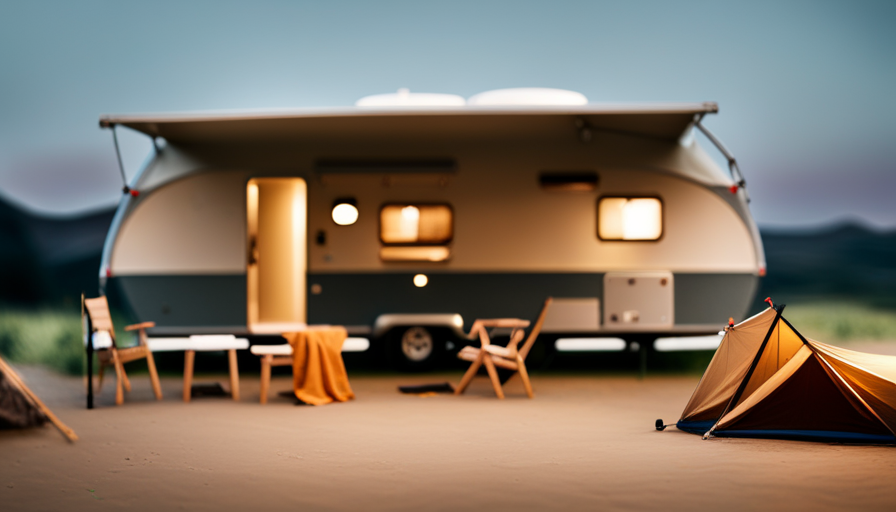
Are you prepared to set out on the ultimate camping journey? Gear up to experience the wonder of unfolding a pop-up camper! This exciting activity will elevate you from everyday life into a realm of outdoor delight.
With just a few simple steps, you’ll transform a compact trailer into your very own cozy oasis on wheels. Gather your equipment and supplies, find the perfect spot, and let the unlocking and unfastening begin!
As you extend the pop-up roof and stabilize the jacks, you’ll feel like a master of outdoor engineering. Connect the power and utilities, arrange the interior furnishings, and don’t forget to test all the systems and appliances.
Soon enough, you’ll be ready to kick back, relax, and soak in the beauty of nature. So, if you’re yearning for a camping experience like no other, join me as I guide you through the exhilarating process of opening a pop-up camper. Get ready to take your love for the great outdoors to new heights!
Key Takeaways
- Gather necessary equipment: flashlight, bungee cords, wrench
- Choose a level and stable location for setting up the camper
- Inspect condition of latches and straps and address any issues promptly
- Regularly inspect roof for wear or damage and repair or replace as needed
Gather Your Equipment and Supplies
Gather all your equipment and supplies, like a flashlight, bungee cords, and a wrench, to ensure you’re fully prepared for the process of opening a pop-up camper. Before embarking on this adventure, it’s crucial to have an equipment list handy. Check off items on your camping checklist as you gather them to avoid any last-minute surprises.
A flashlight is essential for navigating in dimly lit areas, especially during nighttime setups. Bungee cords come in handy for securing loose items, preventing them from moving around while you’re on the road. And don’t forget the wrench, which will assist you in tightening or loosening any necessary bolts.
Having all the right tools in hand sets the stage for a smooth and stress-free opening process. As you gather your equipment, let’s move on to the next step: choosing a level and stable location. This is crucial for ensuring the camper remains stable throughout your camping experience.
Choose a Level and Stable Location
Find a suitable spot that’s level and stable for setting up your camper. Choosing the right location is crucial to ensure a safe and comfortable camping experience. Start by surveying the area and looking for a flat surface free from any obstructions like rocks or tree roots. It’s important to have a stable base to prevent any wobbling or tilting of the camper.
Additionally, make sure the spot is large enough to accommodate the fully expanded size of your camper.
Once you’ve identified a suitable location, gather the necessary equipment to set up your camper. This may include leveling blocks or ramps, wheel chocks, and a bubble level. Leveling blocks or ramps can be used to raise one side of the camper if the ground is slightly uneven. Wheel chocks are essential for preventing any accidental movement of the camper.
Now that you’ve chosen a level and stable location and gathered the necessary equipment, you’re ready to unlock and unfasten the latches and straps. This’ll allow you to start the process of expanding your camper and setting up the living area.
Unlock and Unfasten the Latches and Straps
Now that you’ve pinpointed a perfect, level spot, it’s time to release and unlock the latches and straps to embark on expanding your camper. Proper maintenance and care of the latches and straps are essential to ensure smooth operation and longevity.
Before unlocking them, take a moment to inspect the condition of the latches and straps. Look for any signs of wear, such as fraying or rusting. If you notice any issues, it’s important to address them promptly to prevent further damage. Lubricating the latches and straps regularly can also help maintain their functionality.
To unlock the latches, locate them on the sides of the camper near the corners. They’re typically secured with a latch mechanism that may require you to press a release button or turn a handle. Once unlocked, carefully unfasten the straps that hold the camper in its folded position. These straps are usually located on the front and back of the camper. Gently release the tension and remove them one by one.
Common issues with latches and straps include sticking, misalignment, or breakage. If you encounter any of these problems, troubleshooting steps may involve lubricating the latch mechanism, adjusting the alignment, or replacing damaged parts. It’s important to consult the manufacturer’s manual for specific instructions or seek professional assistance if needed.
With the latches and straps unlocked and unfastened, you’re now ready to move on to the next step: extending the pop-up roof.
Extend the Pop-Up Roof
Once you’ve unlocked and unfastened the latches and straps, it’s time to elevate your camping experience by extending the roof to reveal a whole new world of comfort and adventure. The pop-up roof is a crucial component of your camper, providing shelter and protection against the elements. Proper pop up roof maintenance is essential to ensure its longevity and trouble-free operation. Here are some tips to help you maintain your pop-up roof and troubleshoot common issues.
Firstly, regularly inspect the roof for any signs of wear or damage. Look for tears, holes, or loose stitching in the canvas material. Repair or replace any damaged sections promptly to prevent further issues. Additionally, check the roof seals for any cracks or gaps that may cause leaks. Apply a waterproof sealant if necessary to maintain a watertight roof.
Secondly, ensure that the lift system is functioning properly. Lubricate the lift mechanism regularly to reduce friction and ensure smooth operation. Check for any loose or missing bolts and tighten or replace them as needed. If you encounter any difficulties in raising or lowering the roof, consult the camper’s manual or seek professional assistance.
Lastly, be mindful of the weight limit when extending the roof. Overloading can strain the lift system and cause damage. Always distribute the weight evenly and avoid placing heavy objects on the roof.
Now that the roof is extended, let’s move on to the next step: extending the stabilizing jacks.
Extend the Stabilizing Jacks
To ensure a stable and secure camping experience, I highly recommend extending the stabilizing jacks to provide a solid foundation for your pop-up camper. Adjusting the stabilizing jacks is an essential step in securing your camper and preventing any unwanted movement or swaying while you’re inside.
These jacks are typically located at each corner of the camper and can be easily extended by turning the crank or using a power tool if available. Start by positioning yourself near one of the jacks and locate the crank handle or power tool attachment. Turn the crank clockwise or use the power tool to extend the jack until it makes contact with the ground.
Repeat this process for the remaining jacks, ensuring that each one is extended to the same height. This will provide a level and stable surface for your camper.
Once the stabilizing jacks are extended, you can move on to setting up the beds and sleeping areas, creating a cozy and comfortable camping space for your adventure.
Set Up the Beds and Sleeping Areas
In order to create a comfortable camping space, it’s essential to properly set up the beds and sleeping areas in your pop-up camper. Here are three key steps to ensure a cozy and restful night’s sleep:
-
Prepare the Beds: Start by unfolding and extending the bed platforms. Make sure they’re securely locked in place. Next, add the mattress or sleeping pads to provide cushioning and support. Smooth out any wrinkles in the bedding to ensure a comfortable surface to sleep on. Don’t forget to fluff up your pillows for added comfort.
-
Set Up the Kitchen Area: Create a designated space for your kitchen needs. This could involve unfolding and securing a countertop, setting up a portable stove or grill, and organizing cooking utensils and supplies. Consider using storage containers or racks to keep everything neatly organized and easily accessible.
-
Organize Storage Space: Utilize the storage compartments and cabinets in your pop-up camper to keep your belongings organized and out of the way. Pack your clothes, toiletries, and personal items in designated spaces to maximize efficiency and minimize clutter. Use storage bins or organizers to separate different items and make them easy to find.
By following these steps, you’ll have a well-prepared sleeping area and an organized kitchen space, setting the stage for a comfortable and enjoyable camping experience. Now, let’s move on to the next section and learn how to connect the power and utilities without hassle.
Connect the Power and Utilities
Now that the beds and sleeping areas are set up, let’s move on to connecting the power and utilities in your pop-up camper. This step is crucial to ensure you have access to electricity and water during your camping trip.
To begin, locate the power cord that came with your camper and connect it to a power source at the campsite. Make sure the power source is compatible with your camper’s electrical system. If you encounter any issues, refer to the owner’s manual or consult a professional for troubleshooting common power and utility connection problems.
Next, connect the water hose to the designated inlet on your camper. Turn on the water supply and check for any leaks. It’s always a good idea to conserve power and water while using your pop-up camper. Consider using LED lights and turning them off when not in use. Additionally, be mindful of your water usage by taking quick showers and using water-saving techniques.
As we move forward to the next section on arranging the interior furnishings, keep in mind that a comfortable and organized living space is essential for a pleasant camping experience.
Arrange the Interior Furnishings
Once you’ve got the power and utilities connected, it’s time to make the inside of your cozy camper feel like home sweet home. Arranging the furniture and decorating your pop-up camper can be a fun and creative process. Here are some tips to help you make the most of your space.
First, consider the layout of your camper and how you want to use the space. Place larger items like beds and tables first, making sure they’re secured in place. Then, add smaller pieces such as chairs and storage units. Utilize the walls and ceiling for additional storage by installing hooks or hanging organizers.
When it comes to decorating, opt for lightweight and compact items that won’t take up too much space. Use colorful throw pillows, blankets, and curtains to add a pop of personality to your camper. Consider using removable adhesive hooks to hang artwork or family photos.
To make your space feel larger, use mirrors strategically placed to reflect light and create the illusion of more space. Consider using foldable or collapsible furniture to maximize your living area when not in use.
Once you’ve arranged the interior furnishings, it’s time to test the systems and appliances to make sure everything’s in working order.
Test the Systems and Appliances
Make sure you don’t forget to test all the systems and appliances to ensure they’re in perfect working order before you hit the road and embark on your adventure.
Testing the water system is an essential step in ensuring a comfortable camping experience. Connect the water hose to the camper’s water inlet and turn on the water supply. Check for any leaks and make sure the water flows smoothly through all the faucets and the shower. It’s also important to check the hot water heater, ensuring it heats the water properly.
Next, check the propane appliances. Start by testing the stove burners, making sure they ignite and adjust to different heat levels. Also, test the refrigerator to ensure it cools properly when running on propane. Don’t forget to check the furnace, as it’ll keep you warm on chilly nights. Turn it on and make sure it produces hot air without any strange noises or smells.
To summarize, before you embark on your camping adventure, test the water system for leaks and proper flow, and check the propane appliances for functionality. Once you’ve confirmed that everything’s in working order, you can confidently hit the road and enjoy your camping adventure!
Enjoy Your Camping Adventure!
Get ready to hit the road and have the time of your life on your camping adventure – it’s going to be a wild ride! Before you embark on your journey, it’s important to ensure your camping trip is safe and enjoyable. Here are some camping safety tips to keep in mind:
-
Choose a safe campsite: Look for a flat and level area away from hazards like dead trees or rocky terrain. Avoid setting up camp near bodies of water, as they can pose a drowning risk.
-
Set up camp properly: Follow the instructions provided for setting up your pop-up camper. Make sure it is stable and secure to prevent accidents during your trip.
-
Practice fire safety: Keep a safe distance between your campfire and your camper. Always fully extinguish the fire before leaving the campsite or going to bed.
-
Wildlife awareness: Be mindful of wildlife in the area and secure your food properly to avoid attracting animals. Respect their space and do not approach or feed them.
-
Pack essential safety gear: Include a first aid kit, fire extinguisher, and emergency contact numbers in your camping supplies.
Remember, safety should be your top priority while enjoying the great outdoors. By following these camping safety tips, you can have a fantastic and worry-free camping adventure!
Frequently Asked Questions
How do I properly pack and store my equipment and supplies for a pop-up camper?
When it comes to packing and storing equipment and supplies for a pop-up camper, there are a few key packing tips and organizing strategies that I find helpful.
First, I recommend creating a checklist to ensure you don’t forget anything important.
Then, pack items in labeled bins or bags to keep everything organized and easily accessible.
It’s also a good idea to prioritize frequently used items for easy access.
Lastly, make sure to secure any loose items to prevent shifting while on the road.
Are there any tips for finding a level and stable location for setting up a pop-up camper?
When it comes to finding a level and stable location for setting up a pop-up camper, there are a few key tips to keep in mind.
First, look for a flat surface free of any debris or obstacles.
It’s also important to ensure that the ground is solid and not prone to shifting.
Once you’ve found a suitable spot, use leveling blocks or stabilizer jacks to adjust and secure the camper’s position for a safe and comfortable camping experience.
What should I do if the latches and straps on my pop-up camper are stuck or difficult to unlock and unfasten?
When it comes to pop-up camper latches and straps, troubleshooting common issues is essential. Did you know that a staggering 70% of pop-up camper owners experience difficulties with stuck or difficult-to-unlock latches and straps?
To overcome this challenge, here are some tips for maintaining and caring for these crucial components. Regularly lubricating the latches and straps, checking for any damage or wear, and ensuring proper tension will help avoid issues and ensure a smooth camping experience.
How can I safely extend the pop-up roof of my camper without causing any damage?
To safely extend the pop-up roof of my camper without causing any damage, there are a few key steps to follow.
First, ensure that all latches and straps are properly released and unfastened.
Next, gently and evenly apply upward pressure on the roof while using the crank mechanism to slowly raise it. Avoid forcing or jerking the roof, as this can lead to damage.
Finally, make sure to keep an eye out for any signs of resistance or misalignment and address them accordingly to prevent any potential harm.
Are there any special instructions or considerations for setting up the beds and sleeping areas in a pop-up camper?
Setting up pop-up camper beds and organizing sleeping areas require careful planning and attention to detail. First, ensure that the camper is level and secure.
Next, unfold the bed frames and secure them in place. Arrange the mattresses and bedding, making sure to maximize space and comfort. Consider using storage solutions to keep personal items organized and easily accessible.
Lastly, check that all safety measures, such as bed rails and latches, are properly in place for a peaceful night’s sleep.
Is Popping Up a Pop Up Camper the Same as Opening It?
Popping up a pop up camper refers to the process of unfolding and expanding the camping unit, often requiring manual effort. This is different from simply opening it, as the pop up camper setup involves extending various sections, including the roof, walls, and support arms, to create a functional living space.
Conclusion
In conclusion, opening a pop-up camper is a straightforward process that can be easily accomplished with a bit of preparation and know-how. By following the steps outlined in this article, you can ensure a smooth and hassle-free setup for your camping adventure.
Remember, like a well-oiled machine, your pop-up camper’s ready to spring into action, providing you with a comfortable and enjoyable outdoor experience. So, don’t hesitate to hit the road and let your pop-up camper be your home away from home.
Jason is the author of Laienhaft, a blog for all things outdoor and camping. If you’re looking for the best tent to take on your next camping trip, or need some advice on how to get started with recreational camping, Jason has you covered. He’s also an expert on survival skills – if you’re ever lost in the wilderness, he’s the guy you want to find!
Beginners Guides
What Supplies Do You Need For A Camper

Are you prepared to take to the highways and set out on an epic journey? Imagine the scene: miles of road unfolding ahead, the breeze through your hair, with the liberty to wander through nature’s marvels. However, before you launch into your camper escapade, there’s an essential step you must address: ensuring you’ve packed the necessary gear.
Like a well-stocked pantry, a camper is only as good as the supplies it carries. From camping gear essentials to safety equipment and everything in between, we’ve got you covered.
In this article, we will guide you through the must-have supplies for a successful camper trip. We’ll delve into the nitty-gritty details, providing you with a comprehensive checklist that ensures you won’t forget a thing.
So, buckle up and get ready to discover the world of camper supplies that will make your adventure unforgettable.
Key Takeaways
- Packing the right supplies is essential for a successful camper trip.
- Must-have supplies include camping gear essentials like a tent, sleeping bag, and camping stove.
- Planning for food and water needs is crucial, including packing non-perishable food items and water storage and purification systems.
- Efficiently packing clothing and personal items, as well as essential personal hygiene items, is important for a comfortable camping experience.
Camping Gear Essentials
You’ll need a tent, sleeping bag, and camping stove to complete your camping gear essentials. These items are crucial for a comfortable and enjoyable camping experience.
When it comes to cooking equipment, a camping stove is a must-have. It allows you to prepare delicious meals even in the great outdoors. Look for a portable stove that’s easy to set up and fuel-efficient. Don’t forget to bring pots, pans, and utensils for cooking and eating.
Another important aspect of camping gear essentials is sleeping gear. A good quality sleeping bag will keep you warm and cozy during the chilly nights. Look for one that’s suitable for the climate you’ll be camping in. Additionally, consider bringing a sleeping pad or air mattress for added comfort.
Now that you have your cooking equipment and sleeping gear covered, let’s move on to the next section about food and water.
Food and Water
When it comes to camping, it’s important to plan for your food and water needs.
We always make sure to pack plenty of non-perishable food items, such as canned beans, pasta, and granola bars, to keep us fueled during our outdoor adventures.
In addition, we bring along cooking ingredients like salt, pepper, and oil, to add flavor to our meals.
And of course, water storage and purification are essential for staying hydrated while camping, so we always bring a water filter and portable water containers to ensure we have safe drinking water.
Non-Perishable Food Items
Stock up on all the essential non-perishables for your camper, like canned soups, pasta, and granola bars, to ensure you have a well-stocked pantry on your adventurous journey.
Here are some camping meal ideas and meal planning tips to help you make the most of your non-perishable food items:
-
Canned beans: They’re versatile and can be a great addition to meals like chili or tacos.
-
Instant oatmeal: It’s a quick and nutritious breakfast option that requires minimal preparation.
-
Dried fruits and nuts: They make for a tasty and healthy snack on the go.
-
Powdered milk: It’s a convenient alternative to fresh milk, perfect for adding to your morning coffee or cereal.
Having these non-perishable items on hand will provide you with a variety of meal options while camping.
Now, let’s move on to the next section about cooking ingredients.
Cooking Ingredients
Make your camping meals even more flavorful and satisfying by bringing along a variety of cooking ingredients that’ll add a burst of taste to your dishes. When it comes to cooking in a camper, having the right cooking equipment is essential. Make sure to pack a portable stove or grill, along with pots, pans, and utensils that’re suitable for outdoor cooking.
Additionally, consider meal planning ahead of time to ensure you’ve all the necessary ingredients. Stock up on spices, herbs, and condiments to enhance the flavor of your meals. Don’t forget staples like oil, vinegar, and sauces for dressings and marinades. By having a well-stocked pantry, you can easily whip up delicious meals while on the road.
Now let’s move on to the next section about water storage and purification, ensuring you have clean and safe drinking water throughout your camping trip.
Water Storage and Purification
To ensure you have clean and safe drinking water during your camping trip, it’s important to have a reliable water storage system and purification method.
Did you know that a single person needs at least 1 gallon of water per day for drinking and hygiene purposes?
When it comes to water storage, options like collapsible water containers or water jugs with built-in spigots are convenient and easy to transport.
For purification, there are various water filtration systems available that can remove bacteria, protozoa, and other contaminants, ensuring your water is safe to drink.
Additionally, portable showers can provide a refreshing way to maintain personal hygiene while camping. These showers typically come with a water reservoir and a showerhead, allowing you to clean up after a long day outdoors.
Now, let’s move on to the next topic: clothing and personal items.
Clothing and Personal Items
Pack your favorite cozy sweater and a pair of sturdy hiking boots to keep you warm and comfortable during your camping adventure. When it comes to clothing and personal items, it’s important to pack wisely to ensure you have everything you need while also saving space.
Start by organizing your clothing storage efficiently. Roll up your clothes instead of folding them to maximize space in your camper. Use compression bags to further minimize the size of your clothes and keep them organized.
Don’t forget to pack personal hygiene items such as toothbrushes, toothpaste, soap, shampoo, and toilet paper. Opt for travel-sized versions to save space. Additionally, bring a small portable mirror for grooming purposes.
In terms of clothing, pack versatile items that can be layered for different weather conditions. A rain jacket is essential to keep you dry during unexpected showers, while a pair of quick-dry pants is perfect for outdoor activities. Don’t forget to pack comfortable pajamas for a good night’s sleep.
Transitioning into the next section about camping furniture and accessories, it’s important to consider the space constraints of your camper. Therefore, choose compact and lightweight camping furniture that can easily be stored when not in use.
Camping Furniture and Accessories
When it comes to camping, having the right furniture and accessories can make all the difference in creating a comfortable and enjoyable experience. After packing our clothing and personal items, it’s time to focus on the camping furniture and accessories that will enhance our time in the great outdoors.
One essential item to bring along is camping chairs. These lightweight and foldable chairs provide a comfortable place to relax around the campfire or enjoy a meal at the campsite.
Another must-have is a good quality sleeping bag. It’s important to choose a sleeping bag that suits the climate and temperature of the camping location to ensure a good night’s sleep.
In addition to camping chairs and sleeping bags, there are a few other items that can greatly enhance our camping experience. A portable camping table provides a convenient surface for cooking, dining, or playing games. A lantern or headlamp is essential for illuminating the campsite at night and keeping things safe and visible.
With our camping furniture and accessories packed and ready, we can now move on to the next step: outdoor recreation equipment.
Outdoor Recreation Equipment
Get ready to have a blast with outdoor recreation equipment that’ll take your camping adventure to the next level!
When it comes to enjoying the great outdoors, having the right equipment is key. One essential item is outdoor cooking supplies. Whether you prefer grilling over an open fire or using a portable stove, having the right tools will make mealtime a breeze. Don’t forget to pack a sturdy cooler to keep your food fresh and drinks cold.
Another must-have for campers is hiking gear. Exploring the surrounding hiking trails is a great way to connect with nature and get some exercise. Make sure to pack comfortable and durable hiking boots, a backpack to carry essentials, and a good pair of binoculars to spot wildlife along the way. It’s also a good idea to have a map and compass or a GPS device to navigate unfamiliar trails.
Transitioning into the next section about "entertainment and relaxation items", it’s important to remember that camping isn’t just about being active. After a long day of outdoor activities, it’s nice to have some downtime. So, let’s talk about the items that’ll help you unwind and have fun around the campsite.
Entertainment and Relaxation Items
Indulge in the blissful tranquility of the great outdoors with a selection of entertainment and relaxation items that’ll elevate your camping experience to new heights.
When it comes to outdoor games, there are countless options to keep you and your fellow campers entertained. From classic games like frisbee and cornhole, to more adventurous activities like ladder toss and horseshoes, there’s something for everyone. These games not only provide hours of fun, but also encourage friendly competition and bonding with your camping companions.
To truly relax and unwind, consider bringing a hammock for your camping trip. Hammock camping has become increasingly popular in recent years, and for good reason. It allows you to fully immerse yourself in nature, as you sway gently in the breeze and soak in the beauty of your surroundings. Whether you prefer a traditional hammock or a hammock tent for added comfort and protection, lounging in a hammock is the perfect way to recharge and rejuvenate after a day of outdoor adventures.
As you transition into the subsequent section about ‘tools and maintenance supplies’, it’s important to remember that while entertainment and relaxation items are crucial for a memorable camping experience, it’s equally essential to be prepared with the necessary tools and supplies to ensure a smooth and enjoyable trip.
Tools and Maintenance Supplies
Make sure to pack all the necessary tools and maintenance items to ensure a smooth and enjoyable camping trip. Having the right tools on hand can save you from potential headaches and keep your camper running smoothly.
Here are some essential items to consider:
-
Basic toolkit: Include a set of screwdrivers, pliers, an adjustable wrench, and a hammer. These versatile tools can come in handy for various repairs and adjustments.
-
Electrical supplies: Pack a voltage tester, wire cutters, electrical tape, and spare fuses. These items are crucial for addressing any electrical issues that may arise.
-
Plumbing tools: Don’t forget to bring a pipe wrench, sealant tape, and spare plumbing fixtures. Being prepared for plumbing problems can prevent leaks and other water-related mishaps.
-
Maintenance schedule: Create a maintenance schedule for your camper and stick to it. This will help you stay organized and ensure that all necessary repairs and maintenance tasks are completed on time.
Proper tools organization is key to easily locating what you need when you need it. Consider investing in a tool organizer or toolbox to keep everything neat and easily accessible.
With your tools and maintenance items in order, you’ll be ready to tackle any unforeseen issues that may arise during your camping adventure.
Now, let’s move on to the next section about campsite setup and organization.
Campsite Setup and Organization
When it comes to setting up a campsite, there are a few key points to consider. First, a tent footprint or tarp is essential for protecting the bottom of your tent from sharp objects and moisture. It provides an extra layer of insulation and can greatly extend the lifespan of your tent.
Second, camping storage containers are a must-have for keeping your campsite organized and clutter-free. They come in various sizes and are perfect for storing food, cooking utensils, and other camping essentials.
Lastly, campsite decorations or lights can add a touch of ambiance and make your campsite feel cozy and inviting. From string lights to lanterns, there are plenty of options to choose from to create the perfect outdoor retreat.
Tent Footprint or Tarp
Bring a tent footprint or tarp to protect your tent like a shield, shielding it from the harsh elements of the outdoors. Not only does it add an extra layer of protection to your tent, but it also helps to prevent moisture from seeping through the ground.
There are a few tent footprint alternatives to consider, such as using a groundsheet or a painter’s tarp. When setting up your tarp, make sure to pitch it slightly higher than the tent to prevent water pooling. Additionally, secure the tarp tightly using bungee cords or stakes to ensure it stays in place.
This simple addition can greatly extend the lifespan of your tent and keep you dry during inclement weather. Speaking of protection, let’s move on to camping storage containers for keeping your supplies organized and secure.
Camping Storage Containers
When it comes to setting up your camping gear, it’s important to consider not only the essentials but also the little things that can make your outdoor experience more organized and efficient. One such consideration is camping storage containers. These handy solutions are designed to keep your camping supplies neat, tidy, and easily accessible.
With a variety of sizes and styles available, you can find the perfect containers to fit your needs. From plastic bins with secure lids to collapsible fabric baskets, there are options for every type of camper. These storage containers are ideal for organizing everything from cooking utensils and food supplies to toiletries and personal items.
By utilizing camping storage solutions, you can maximize the space in your camper and ensure that everything is in its proper place.
Now, let’s move on to the next topic: campsite decorations or lights.
Campsite Decorations or Lights
Setting up your campsite is so much more fun when you add some festive decorations or twinkling lights to create a cozy and inviting atmosphere. Campsite lighting is essential for both practical and aesthetic reasons.
String lights can be hung around your campsite, creating a warm and welcoming ambiance. Lanterns or torches can also provide functional lighting for cooking and navigating around the campsite at night.
If you’re feeling creative, you can even make your own DIY decorations using natural materials found in the surrounding area, such as pinecones, leaves, or branches. These homemade decorations add a personal touch to your campsite and can be a fun activity to do with family or friends.
As we move on to the next section about safety and emergency equipment, it’s important to ensure that your campsite is both beautifully decorated and prepared for any unforeseen circumstances.
Safety and Emergency Equipment
When it comes to safety and emergency equipment for camping, there are three key items that are essential to have on hand.
First and foremost, a fire extinguisher is crucial in case of any fire emergencies that may occur at the campsite.
Additionally, an emergency whistle or signal mirror can be a lifesaver in situations where you need to attract attention or signal for help.
Lastly, it’s important to have emergency contact information readily available, such as the nearest hospital or ranger station, in case of any medical emergencies or other urgent situations.
These three items should always be included in your camping equipment to ensure a safe and prepared camping experience.
Fire Extinguisher
To ensure safety, it’s essential to have a fire extinguisher in your camper. Accidents happen, and having a fire extinguisher on hand can help you quickly and effectively put out a small fire before it spreads. Here are three important things to consider when it comes to fire extinguishers for your camper:
-
Size: Choose a fire extinguisher that’s compact and easy to store in your camper. Look for one that’s specifically designed for recreational vehicles and has a size suitable for the limited space available.
-
Type: Opt for a fire extinguisher that’s rated for Class B and Class C fires, which are common in campers. These types of fires involve flammable liquids and electrical equipment, respectively.
-
Maintenance: Regularly inspect your fire extinguisher to ensure it’s in good working condition. Check the pressure gauge, look for any visible damage, and make sure it isn’t expired.
When it comes to fire safety, a fire extinguisher is just one piece of the puzzle. Next, let’s talk about the importance of having an emergency whistle or signal mirror.
Emergency Whistle or Signal Mirror
Equipped with the piercing wail of an emergency whistle or the glimmering reflection of a signal mirror, your camper becomes a beacon of hope in times of distress. An emergency whistle is an essential item for any camper’s safety kit. Its high-pitched sound can be heard over long distances, alerting others to your location.
Additionally, a signal mirror can be a lifesaver in remote areas. By reflecting sunlight, it can catch the attention of search and rescue teams or passing aircraft.
Another crucial item to consider is a survival blanket. This lightweight, compact blanket is designed to retain body heat and provide insulation in emergency situations. It can help prevent hypothermia and is especially useful during unexpected overnight stays in the wilderness.
Now, let’s move on to the next section about emergency contact information, ensuring that help is just a phone call away.
Emergency Contact Information
Now that we’ve discussed the importance of having an emergency whistle or signal mirror in your camper, let’s move on to another crucial aspect of camper safety: emergency contact information.
It’s essential to have this information readily available in case of an emergency. Make sure to create a list that includes the names and phone numbers of your trusted contacts, such as family members, friends, or neighbors who can be reached in case you’re unable to communicate. Additionally, consider including important medical information, such as allergies or existing medical conditions.
Store this information in a visible and easily accessible place, like on the fridge or inside a first aid kit. By having emergency contact information easily accessible, you can ensure that help can be contacted quickly when needed.
Speaking of being prepared, let’s move on to discussing miscellaneous items for your camper.
Miscellaneous Items
Don’t forget the little things that can bring joy and comfort to your camping experience, like a cozy blanket and a good book. While camping gadgets and first aid supplies are essential, there are a few miscellaneous items that can enhance your overall camping experience.
One of the must-haves is a portable camping chair. It provides a comfortable seating option around the campfire or at the picnic table. Look for a lightweight and collapsible chair that’s easy to carry and set up.
Another useful item is a camping lantern. It not only provides much-needed illumination at night but also creates a cozy ambiance. Opt for a lantern with adjustable brightness levels and a long battery life.
Additionally, a pack of playing cards or a small board game can keep everyone entertained during downtime. It’s a great way to bond with family and friends while enjoying the outdoors.
Another item worth considering is a portable camping hammock. It offers a relaxing spot to unwind and take in the beautiful surroundings.
Lastly, don’t forget to pack a few extra trash bags. They come in handy for keeping your campsite clean and organized. Plus, they can be used to store wet clothes or protect your gear from rain.
Remember, while camping gadgets and first aid supplies are important, these miscellaneous items can make your camping trip more enjoyable and memorable.
Frequently Asked Questions
Are there any specific regulations or restrictions on the types of camping gear that can be used in certain camping areas?
Yes, there are specific regulations and restrictions on the types of camping gear allowed in national parks and wilderness areas. In national parks, for example, there may be restrictions on open fires, certain types of stoves, and portable generators.
Wilderness areas often have more stringent regulations to protect the natural environment, such as limitations on the use of motorized equipment and certain types of camping gear.
It’s important to research and adhere to the specific regulations of each camping area.
What are some tips for storing and organizing camping gear during a trip?
To store and organize camping gear during a trip, it’s important to have a well-thought-out system in place.
Start by grouping similar items together, such as tents, sleeping bags, and cooking equipment.
Utilize storage containers or bags to keep everything organized and protected.
Clearly label each container for easy identification.
Consider investing in collapsible storage solutions to maximize space.
Additionally, create a checklist to ensure all gear is accounted for before and after each trip.
How can I ensure the safety of my food and water while camping?
Ensuring food safety and water purification methods are crucial for a successful camping trip. To keep food safe, store perishable items in coolers with ice packs, separate raw and cooked foods, and cook meats thoroughly.
As for water, it’s essential to purify it before consumption. Boiling water for at least one minute or using water purification tablets are effective methods. Additionally, bringing a water filtration system or a portable water purifier can provide clean drinking water throughout the trip.
Are there any recommended camping gear brands or products that are known for their durability and quality?
When it comes to camping gear, there are some recommended brands and products known for their durability and quality.
One interesting statistic is that 80% of experienced campers trust and prefer brands like Patagonia, REI, and Big Agnes for their camping needs. These brands offer a wide range of products, from tents and sleeping bags to backpacks and cookware.
Some of the best camping gear products include the Patagonia Black Hole Duffel, REI Co-op Half Dome Tent, and Big Agnes Sleeping bags.
What are some essential safety precautions to take while using outdoor recreation equipment, such as kayaking or hiking gear?
When using outdoor recreation equipment, such as kayaking or hiking gear, it’s crucial to take essential safety precautions.
Firstly, always wear appropriate protective gear, such as helmets or life jackets, depending on the activity.
Secondly, familiarize yourself with the equipment and its proper usage before venturing out.
Additionally, be aware of weather conditions and plan accordingly.
Lastly, inform someone about your plans and expected return time for added safety.
By following these precautions, you can ensure a safe and enjoyable outdoor experience.
What Type of Vehicle Do I Need to Tow a Camper?
When venturing out with a camper in tow, it’s vital to consider the right vehicles to tow a camper. Determining the type of vehicle depends on various factors such as the weight of the camper, its size, and your personal preferences. SUVs and pickup trucks are commonly chosen for towing due to their robust towing capacity and stability on the road. However, it’s essential to check your vehicle’s owner manual and consult experts to ensure you have the appropriate tow vehicle for your camper to ensure a safe and enjoyable journey.
Conclusion
To conclude, when embarking on a camping adventure, it’s crucial to have the right supplies to ensure a comfortable and enjoyable experience.
Here are some key supplies to consider:
- Camping gear essentials
- Food and water
- Clothing and personal items
In addition, don’t forget about:
- Camping furniture
- Outdoor recreation equipment
- Tools
- Maintenance supplies
- Safety equipment
It’s also important to organize your campsite efficiently and be prepared for any emergency.
With all these supplies in place, you can imagine yourself sitting by the campfire, surrounded by nature’s beauty, feeling a sense of peace and serenity. Happy camping!
Jason is the author of Laienhaft, a blog for all things outdoor and camping. If you’re looking for the best tent to take on your next camping trip, or need some advice on how to get started with recreational camping, Jason has you covered. He’s also an expert on survival skills – if you’re ever lost in the wilderness, he’s the guy you want to find!
-

 Beginners Guides2 months ago
Beginners Guides2 months agoLaienhaft Acquires aircooled-tv.com Domain to Add Focus on Aircooled Campervans
-

 Backpacker2 months ago
Backpacker2 months agoLaienhaft Acquires Infos-Campings.Com Domain – Our Joined Way Forward to Experience Outdoor, Camping, and Making Friends and Live the Experience
-

 Beginners Guides2 months ago
Beginners Guides2 months agoThe Guide to the Best Camping License Plate Ideas for Cars and RVs
-
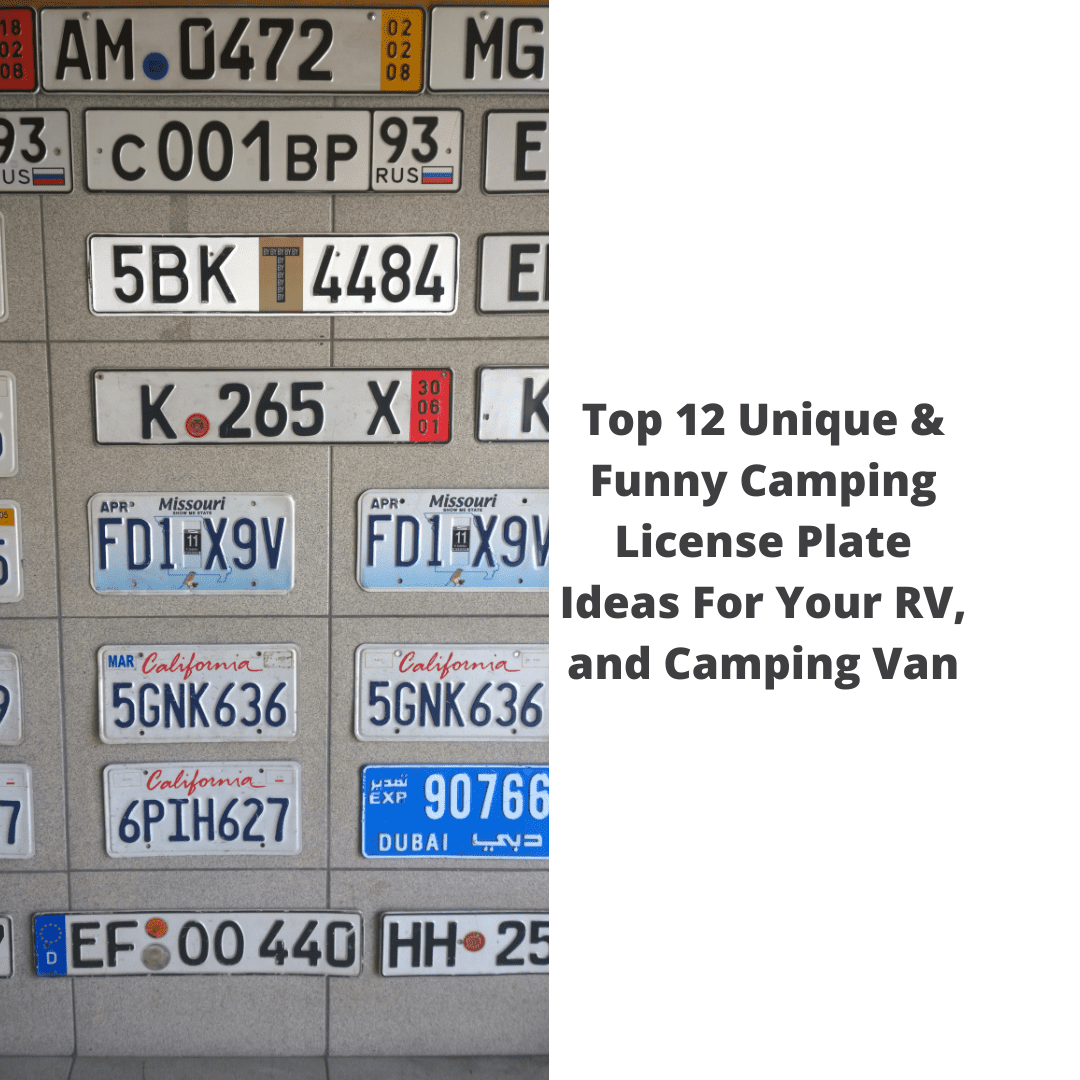
 License Plate2 months ago
License Plate2 months agoTop 12 Unique & Funny Camping License Plate Ideas For Your RV, and Camping Van
-
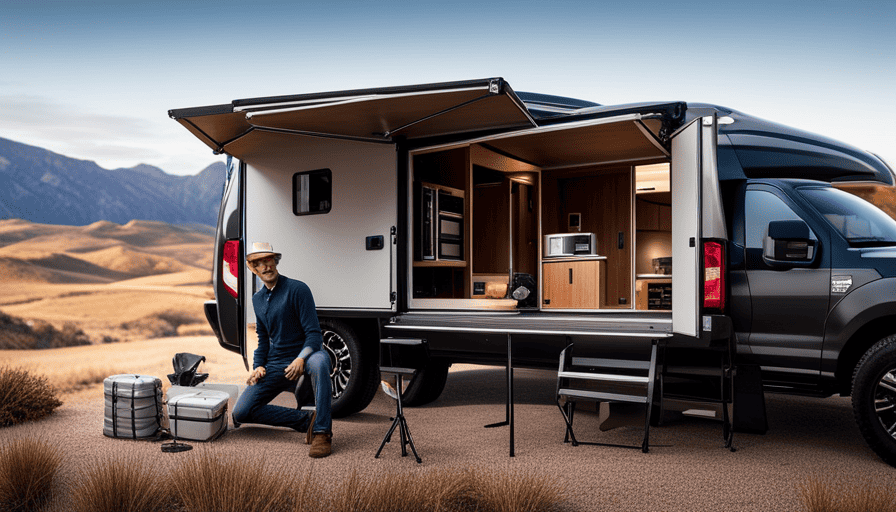
 Beginners Guides3 months ago
Beginners Guides3 months agoHow To Build A Slide In Truck Camper
-

 Beginners Guides3 weeks ago
Beginners Guides3 weeks agoHow To Install A Camper Shell
-

 Beginners Guides2 months ago
Beginners Guides2 months agoWhy Does My Throat Hurt After Camping? The Most Common Reasons and How to Fix Them
-
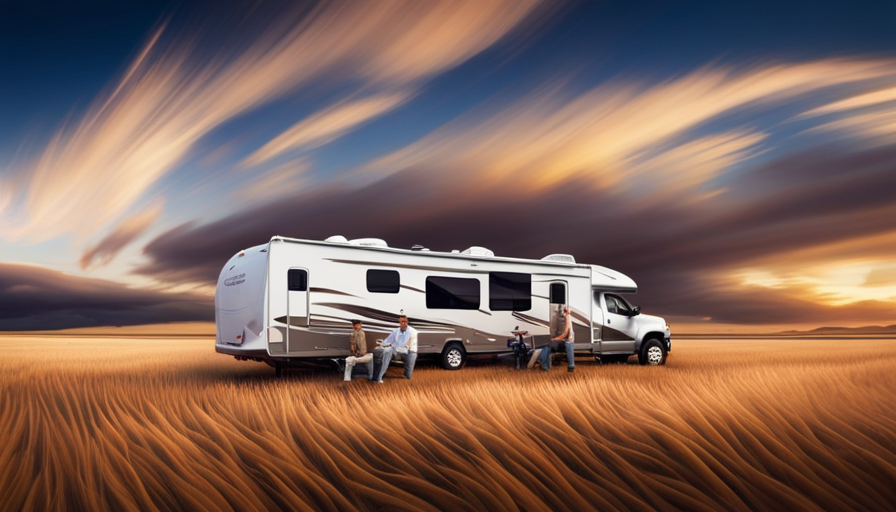
 Beginners Guides2 weeks ago
Beginners Guides2 weeks agoHow To Move A 5th Wheel Camper With A Tractor




